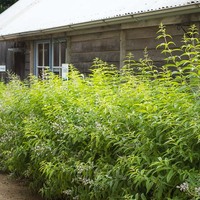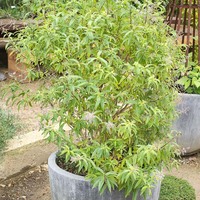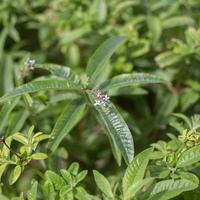Common name: Lemon Verbena
Other common names: Lemon Beebrush
Description
Lemon Verbena is an aromatic shrub native to subtropical South America, its native range extending across parts of Argentina, Brazil, and Chile. Introduced long ago in other parts of the Americas, Europe and Africa, it is grown commercially today in many countries for its leaves, which yield a lemon-scented essential oil. Producing countries include its native Argentina, Brazil, Chile, and Mexico, Venezuela, Bolivia, Peru, Uruguay, the south of France and Algeria.
It is typically a leggy shrub 1 to 3 m (3 to 10 ft) tall. However, in tropical climates, it can grow into a small tree reaching up to 6 m (20 ft) tall, more so if unpruned allowed to grow naturally.
Leaves are sword-shaped, light green and arranged in propeller-like clusters of three to four borne at nodes along the branches. When crushed, they release a strong lemon fragrance, considered the truest to Lemon (Citrus limon) of all the lemon-scented plants. Although deciduous in cold climates, it is semi-evergreen to evergreen in the tropics, with most leaves remaining on the plant throughout the year.
Flowers tiny, white to lavender and borne on flower spikes arising at the end of branches. They bloom from summer to autumn and, like the leaves, have a delightful lemon-scented fragrance. Despite being functionally hermaphrodite, with both female and male parts, they are seldom pollinated. As a result, few to no seed are produced.
Use
The leaves yield on steam distillation a lemon-scented essential oil known as 'Verbena oil', its fragrance resulting from a high Citral content, the same chemical compound giving lemons their lemony aroma. It is a pale yellow liquid with wide application in scenting medicines, soaps, household cleaning products and flavouring food. However, its use in perfumery has been discontinued due to its skin sensitising and phototoxic properties.
Around 4,000 to 6,000 kilograms (9000 to 13000 lbs) of fresh leaves are harvested per hectare per year in commercial plantations, and with an oil content of 0.1 to 0.7% yield, on average, 20 kilograms of oil, the equivalent of 18 pounds of oil per acre. Because the oil yields are very low, the leaves are steam-distilled as soon as possible after harvest to minimise vaporisation.
The leaves are also used fresh or dried for tea and to add lemon fragrance and flavour to poultry, seafood, vegetable dishes, desserts and drinks, both alcoholic and non-alcoholic. The leaves and essential oil are also added to potpourri mixtures and air fresheners used to scent and deodorise rooms in homes and cars. Many consider its aroma and flavour the finest of all lemon-scented plants.
It is a popular plant in home gardens wherever the climate is suitable and is grown both as a herbal and fragrant plant for its aromatic leaves. It is commonly grown in large containers or planted as an informal hedge.
Health use
Lemon Verbena has digestive and calming properties. The leaves are made into a tea to relieve intestinal gas and bloating and act as a gentle sedative. Its sedative properties are reportedly similar to but less potent than Lemon Balm (Melissa officinalis).
Climate
Grows naturally and is productive in sub-humid to moderately humid subtropical and tropical mid-elevation climates, generally areas with annual lows of 8 to 20°C, annual highs of 19 to 32°C, annual rainfall of 600 to 2000 mm and a dry season of 3 to 6 months, extending to 12 months with irrigation. Commercial plantations producing essential oil are located mostly in subtropical areas receiving annual rainfall of 1200 mm or less.
Growing
New plants are grown from cuttings, as seed are not always readily available. It performs best on free-draining loam and sand soils of a mildly acid to mildly alkaline nature, generally with a pH of 6.0 to 7.5 and on sites with partial sun exposure. Full sun exposure in warm climates, especially during the sun intense afternoon hours, may bleach the leaves, resulting in some flavour loss.
It forms a straggly or untidy canopy that benefits from pruning or frequent leaf harvesting to maintain an attractive shape, particularly for the home garden.
Lemon Verbena is highly susceptible to fungal disease brought on by hot, humid conditions.
Problem features
Lemon Verbena is recorded as having escaped cultivation. However, there does not appear to be any record of it anywhere as a serious weed, despite its widespread introduction and cultivation. This may be due, in part, to its shy seeding habit, producing seed in small amounts, infrequently or not at all. It is assessed as a low weed risk species for Hawaii by the Hawaii Pacific Weed Risk Assessment (HPWRA) project.
Where it grows
References
Books
-
Chevallier, A. 2000, Encyclopedia of herbal medicine, 2nd American ed., Dorling Kindersley, New York
-
Church, G. & Greenfield, P. 2002, Trees and shrubs for fragrance, David Bateman, Auckland, New Zealand
-
Editors of Sunset Magazine 2012, The New Western Garden Book: The Ultimate Gardening Guide, 9th edition, Sunset Publishing Corporation, California
-
Groom, N. 1997, The new perfume handbook, 2nd ed., Blackie Academic & Professional, London
-
Guenther, E. & Althausen, D. 1948 to 1952, The essential oils (6 volumes), Van Nostrand Publishing, New York
-
Macmillan, H. F. 1943, Tropical planting and gardening : with special reference to Ceylon, 5th ed, Macmillan Publishing, London
-
Randall, R. P. 2007, The introduced flora of Australia and its weed status, Cooperative Research Centre for Australian Weed Management, Glen Osmond, South Australia
-
Seidemann, J. 2005, World spice plants: economic usage botany taxonomy, Springer-Verlag, Berlin
-
Stewart, A. 2013, The drunken botanist : the plants that create the world's great drinks, 1st ed., Algonquin Books, Chapel Hill, North Carolina
-
Van Wyk, B. E. 2005, Food plants of the world: an illustrated guide, 1st ed., Timber Press, Portland, Oregon




